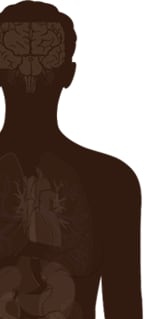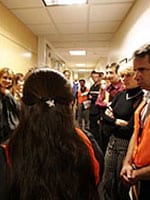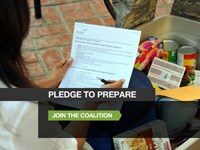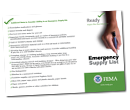Did you know HealthPro offers several eLearning classes?
You can sign up for the following courses:
ACLS Heartcode Online + Skills
BLS Heartcode Skills Session
BLS Healthcare Provider Online Part 1 Skills Part 2
Heartsaver CPR/AED Skills Session
Heartsaver First Aid Skills Session
PALS Heartcode Online + Skills
PALS Heartcode Skills Session
PHTLS Hybrid'Rapid STEMI ID (5 CEUs)
Register at hpec.org or give us a call at 951-279-6110.
Monday, September 22, 2014
Friday, September 19, 2014
Yo Ho Ho - It's time to learn CPR Mateys!
Thursday, September 18, 2014
Heart Attack 101
A Heart Attack occurs when the blood flow that brings oxygen to the heart muscle is severely reduced or stopped. This happens because coronary arteries that supply the heart with blood can slowly become thicker and harder from a buildup of fat, cholesterol and other substances, called plaque. This slow process is known as atherosclerosis. If the plaque breaks open and a blood clot forms that blocks the blood flow, a heart attack occurs.
Wednesday, September 17, 2014
Reducing Sodium in Children's Diets
The pressure is on to keep blood pressure down
September 2014


 90%
90%
About 90% of US children ages 6-18 years eat too much sodium daily.
 10
10
10 common types of foods contributed more than 40% of the sodium eaten by children.
 1 in 6
1 in 6
1 in 6 children has raised blood pressure, which can be lowered in part by a healthy diet, including less sodium.
About 9 in 10 US children eat more sodium than recommended. Most sodium is in the form of salt, as a part of processed foods. A high sodium diet can lead to high blood pressure. About 1 in 6 children ages 8-17 years has raised blood pressure. High blood pressure is a major risk factor for heart disease and stroke. Lowering sodium in children's diets today can help prevent heart disease tomorrow, especially for those who are overweight. The taste for salt is established through diet at a young age. Parents and caregivers can help lower sodium by influencing the way foods are produced, sold, prepared, and served.
As a parent and caregiver, you can:
- Model healthy eating for your children by having a diet rich in fruits and vegetables without added sodium.
- Compare Nutrition Facts labels to choose the lowest sodium option before you buy.
- Ask your grocery manager to provide more low sodium options of your family's favorite foods.
- Request restaurant nutrition information to make lower sodium choices.
HealthPro is offering a PALS Renewal course this Saturday, September 20, 2014 from
10am-2pm at our Orange County Location. Sign up at hpec.org or give us a call at 951-279-6110.
Tuesday, September 16, 2014
New Jersey becomes 19th state to require CPR in Schools
New Jersey becomes 19th state to require CPR in Schools
Published: 12:10 pm CDT, September 15, 2014 Laurie Heavener was talking with another mother outside her daughter’s Girl Scout meeting in Randolph, New Jersey, when her eyes rolled back in her head and she collapsed from cardiac arrest. A high school sophomore administered CPR, just one day after he received training.
Laurie Heavener was talking with another mother outside her daughter’s Girl Scout meeting in Randolph, New Jersey, when her eyes rolled back in her head and she collapsed from cardiac arrest. A high school sophomore administered CPR, just one day after he received training.
More than six years later, Heavener was there to watch New Jersey’s Lt. Governor Kim Guadagno, serving as acting governor, sign a bill into law making the state the 19th in the nation to require students learn CPR to graduate high school.
“Put simply, this law will save lives,” said Guadagno at the bill signing. “These critical skills are easy to learn and can make all the difference in the world to someone in cardiac arrest. These skills can be learned in 30 minutes or one class period. Frankly, I can’t think of a better use of a half hour.”
The efforts to pass a CPR in Schools law in New Jersey began last year, when volunteers traveled to Trenton to speak with their legislators.
“We had been trying to get legislators to sponsor a CPR in Schools bill,” said Corinne Orlando, the American Heart Association’s government relations director in New Jersey. “Laurie shared her story with legislators during the June 2013 Lobby Day, and Sen. Diane Allen, R-Edgewater Park, agreed that day to sponsor a bill.”
A few months later, bills were introduced in the state House and Senate.
Then on May 15, Heavener returned to the statehouse to testify before the Assembly Education Committee. 

“This law means that all of our kids will learn CPR. We are empowering all of our students to save lives. The boy who saved me knew CPR because his school thought outside of the box and taught it,” she said.
The bill passed with only one dissenting vote.
Cardiologist Dr. William Tansey III, an advocate for the law, said that “by teaching high school students this important skill, New Jersey will be creating a generation of lifesavers.”
“This bill is important not just to me, but to the 424,000 people like me who suffer sudden cardiac arrest each year,” said Heavener, a mother of four. “It’s amazing that only 11 percent survive. The only thing to save people is CPR or an AED. I can’t believe New Jersey is only the 19th state to pass this law. C’mon – all states should have this.”
Advocates continue to push in the rest of the nation for similar laws. In neighboring New York, a CPR in Schools bill passed the state Assembly and the state Senate this year – the farthest it’s ever gotten.
 It currently needs Gov. Andrew Cuomo’s signature. From there, it must go to the New York State Commissioner of Education, who has 180 days to make a recommendation to the state Board of Regents to include it in the curriculum.
It currently needs Gov. Andrew Cuomo’s signature. From there, it must go to the New York State Commissioner of Education, who has 180 days to make a recommendation to the state Board of Regents to include it in the curriculum.
“Most sudden cardiac arrest happens in the home,” said Dan Moran, president of Next-Act in Colonie, New York, and chair of the New York State Advocacy Committee. “We need this law so that everyone has access to CPR.”
Access is a point on why advocates push for CPR to be taught through the school system.
“Our continued research shows disparities exist in learning and performing CPR, and we are ready to move beyond documenting gaps to finding solutions to fix them,” said Dianne Atkins, professor of Pediatrics at the University of Iowa. “School is a great equalizer, which is why CPR in schools is an integral part of the solution and will help increase bystander CPR across all communities and save more lives.”
Latinos and African-Americans are 30 percent less likely to have bystander CPR performed on them in an emergency, according to AHA research. People who live in lower-income, African-American neighborhoods are 50 percent less likely to have CPR performed.
 The AHA is training students, teachers and parents via CPR in Schools to help eliminate inequities. Ross Dress for Less is supporting AHA’s efforts to help save more lives by providing free CPR training resources to public schools in lower-income areas
The AHA is training students, teachers and parents via CPR in Schools to help eliminate inequities. Ross Dress for Less is supporting AHA’s efforts to help save more lives by providing free CPR training resources to public schools in lower-income areas
The AHA’s goal is to pair each Ross Dress for Less store with a nearby public school that has at least 50 percent of their students receiving free or reduced lunch.
Under the program, more than 1,100 schools in the U.S. will receive a CPR in Schools Training Kit, teaching materials and a tool that will track how many students they have trained. Teachers also have access to AHA resources, volunteers and CPR in Schools staff throughout the program.
For more information:
Source: AHAHealthPro offers:
Instructor, Provider and Renewal Courses, Combo Course Options, Online Education, EMS and Nursing CEU’s. Sign up at hpec.org or give us a call at 951-279-6110.
Wednesday, September 10, 2014
Basic Disaster Supplies Kit
Basic Disaster Supplies Kit
A basic emergency supply kit could include the following recommended items:
- Water, one gallon of water per person per day for at least three days, for drinking and sanitation
- Food, at least a three-day supply of non-perishable food
- Battery-powered or hand crank radio and a NOAA Weather Radio with tone alert and extra batteries for both
- Flashlight and extra batteries
- First aid kit
- Whistle to signal for help
- Dust mask to help filter contaminated air and plastic sheeting and duct tape to shelter-in-place
- Moist towelettes, garbage bags and plastic ties for personal sanitation
- Wrench or pliers to turn off utilities
- Manual can opener for food
- Local maps
- Cell phone with chargers, inverter or solar charger
HealthPro is an AUTHORIZED TRAINING CENTER - align your training site with HealthPro today! Contact us at hpec.org or 951-279-6110.
Tuesday, September 9, 2014
National Preparedness Month Is Here!
Be Ready, Nat´l Preparedness Month is Here!
 Would you be ready if there were an emergency? Be prepared: throughout September there will be activities across the country to promote emergency preparedness.
Would you be ready if there were an emergency? Be prepared: throughout September there will be activities across the country to promote emergency preparedness.Throughout September there will be activities across the country to promote emergency preparedness. More than 3,000 organizations – national, regional, and local public and private organizations – are supporting emergency preparedness efforts and encouraging all Americans to take action.
Join the effort! Visit our Web site for "Emergency Preparedness and Response" and follow these four steps:
September 2014 marks the eleventh annual National Preparedness Month, sponsored by the Federal Emergency Management Agency in the US Department of Homeland Security. One goal of Homeland Security is to educate the public about how to prepare for emergencies, including natural disasters, mass casualties, biological and chemical threats, radiation emergencies, and terrorist attacks.
 During September, emergency preparedness will focus on:
During September, emergency preparedness will focus on:- Home and family preparedness, including pets, older Americans, and individuals with disabilities and special needs (Ready.gov)
- Back-to-school (Ready Kids/Sea Un Héroe)
- Business preparedness (Ready Business)
- Preparación en Español (Listo America)
- Developing a family disaster plan
- Gathering emergency supplies
- Learning how to shelter in place
- Understanding quarantine and isolation
- Learning how to maintain a healthy state of mind
Get an Emergency Kit
If disaster strikes your community, you might not have access to food, water, or electricity for some time. By taking time now to prepare emergency water supplies, food supplies and a disaster supplies kit, you can provide for your entire family.Review the items recommended for a disaster supplies kit or print the Homeland Security Emergency Supply checklist.
 Make an Emergency Plan
Make an Emergency Plan
Make plans with your family and friends in case you're not together during an emergency. Discuss how you'll contact each other, where you'll meet, and what you'll do in different situations. Read how to develop a family disaster plan or fill out the Homeland Security Family Emergency Plan.Ask about planning at your workplace and your child's school or daycare center. The US Department of Education gives guidelines for school preparedness. Workers at small, medium, and large businesses should practice for emergencies of all kinds. See Ready Business for more information.
Be Informed
Being prepared means staying informed. Check all types of media – Web sites, newspapers, radio, TV, mobile and land phones – for global, national and local information. During an emergency, your local Emergency Management or Emergency Services office will give you information on such things as open shelters and evacuation orders. Check Ready.gov community and state information to learn about resources in your community.
 Get Involved
Get Involved
Look into taking first aid and emergency response training, participating in community exercises, and volunteering to support local first responders. Contact Citizens Corps, which coordinates activities to make communities safer, stronger and better prepared to respond to an emergency situation. Contact the Medical Reserve Corps, (MRC). MRC are community-based units and function as a way to locally organize and utilize volunteers who want to donate their time and expertise to prepare for and respond to emergencies and promote healthy living throughout the year.Homeland Security promotes emergency preparedness all year round via the Ready America campaign. Checklists, brochures, and videos are available in English and in Spanish online and by phone (1-800-BE-READY and 1-888-SE-LISTO).
More Information
More Information
- CDC’s Emergency Preparedness and Response
- Ready.gov (US Department of Homeland Security)
- Preparedness e-Cards
Subscribe to:
Posts (Atom)


